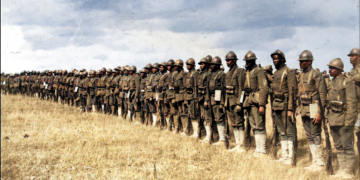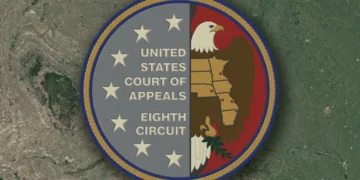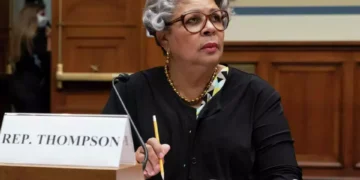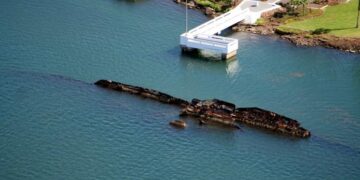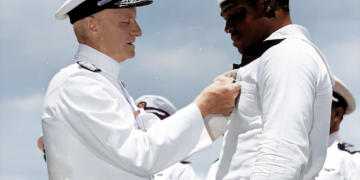July 14, 2025 Story by: Editor
When Allied forces stormed the beaches of Normandy on June 6, 1944, a little-known but highly specialized all-Black U.S. Army unit was already on the sand, executing a dangerous mission that would help shape the success of D-Day: the 320th Barrage Balloon Battalion.
Composed entirely of African American soldiers during an era of segregation, the 320th’s role was critical — launching and managing barrage balloons, floating aerial mines designed to deter and damage enemy aircraft. Though their story remained largely unrecognized for decades, their contribution to the largest amphibious invasion in history is finally gaining the recognition it deserves.
“They flew at an altitude of around 200 feet to defend soldiers landing on the beaches against strafing attacks by German aircraft,” a commendation by Supreme Allied Commander Gen. Dwight D. Eisenhower cited.

Photo caption: The men of the HQ battery of the 320th Barrage Balloon Battalion pose in France, July 1944. (Photo courtesy of Linda Hervieux)
The battalion served for over four months in France. In late July 1944, Battery A of the 320th moved from Omaha Beach to the port city of Cherbourg. The remaining three batteries stayed on Omaha and Utah beaches until early October, when deteriorating weather prevented ships from landing.
By the end of October 1944, the 320th Battalion was on its way back to Camp Stewart in Georgia to train for service in the Pacific Theater. Fortunately for the group, the war ended before they reached the Pacific.
Aside from being the first Black unit to arrive on D-Day, the 320th was also the only American barrage balloon unit in France.
The unit’s last surviving member, Henry Parham, passed away in July 2021 at the age of 99.
The Role of Barrage Balloons on D-Day
Barrage balloons were large, hydrogen-filled blimps tethered to the ground by steel cables. Their purpose was simple but effective: force enemy aircraft to fly higher — outside of effective strafing or bombing range — or risk crashing into the cable lines. On D-Day, the beaches were especially vulnerable to low-flying Luftwaffe attacks, and the 320th was responsible for creating an aerial shield.
Members of the 320th landed on Utah and Omaha beaches in the first assault waves. Despite intense enemy fire, they began inflating and anchoring barrage balloons almost immediately — often under sniper and mortar attack. Their success helped protect landing troops, vehicles, and equipment during the most chaotic hours of the invasion.

Photo caption: Members of the 320th Barrage Balloon Battalion haul a barrage balloon through a partially cleared minefield in France on Aug. 14, 1944, From left to right are Arko Shaw, Alvin Smith, Jessie Sumlin, and James Shrapshire.(Photo: National Archives and Records Administration)
Who Were the Men of the 320th?
The 320th Barrage Balloon Battalion was the only African American combat unit to land on D-Day. Most of its soldiers had been recruited from across the segregated South and trained at Camp Tyson, Tennessee, which served as the Army’s primary barrage balloon training center.
Despite operating in a racially segregated military, these men:
- Carried out a high-stakes, technical mission.
- Proved their capability under direct fire.
- Helped alter the perception of Black servicemen in World War II.
Their commanding officer, Capt. Leonard Willette, led with distinction and was among the first African American officers to command an all-Black combat unit in a major Allied operation.
Legacy and Recognition
For decades, the 320th received little attention in mainstream D-Day narratives. Unlike other more publicized units, the 320th’s service was buried under a combination of systemic racism and the secrecy of their specialized mission.
But recent efforts — including documentation by the Smithsonian’s National Air and Space Museum, oral histories from surviving veterans, and independent historical research — have begun to shed light on their importance.
In 2009, members of the 320th were finally recognized with a presidential unit citation, and some surviving members have since been honored at national D-Day commemorations.

Photo caption: Trucks, bulldozers, jeeps and other equipment arrive on Omaha Beach on June 9, 1944. A lone “sky sentinel” floats in the background. (Photo courtesy of: National Archives and Records Administration)
A Historic First
The 320th was not only the first barrage balloon unit to land on the beaches of Normandy — they were also:
- The first African American unit in U.S. history to take part in a major amphibious assault.
- A direct challenge to the segregationist assumptions that Black troops could not serve in complex, high-stakes combat roles.
Their bravery helped pave the way for the desegregation of the U.S. military in 1948, and their story continues to inspire new generations of historians, veterans, and civil rights advocates.
Conclusion
The 320th Barrage Balloon Battalion did more than protect Allied troops from German aircraft — they defied a system that underestimated them, endured in silence, and helped reshape the story of American service and sacrifice. As the fight for historical recognition continues, their role on D-Day stands as a quiet triumph of courage, skill, and dignity.
Source: National Air and Space Museum / War Memorial



